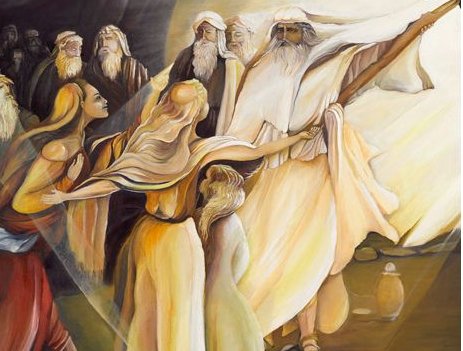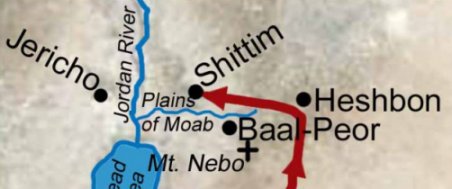Month 2:1, Rosh Chodesh, Year:Day 5941:31 AM
2Exodus 4/40, (Omer Count - Shabbat #2)
Gregorian Calendar: Thursday 27 April 2017
Rosh Chodesh II
Jericho March I 2017
& the Midianite Connection

Continued from Part 35 (Complete Jericho Marches)
Introduction
Chag sameach Rosh Chodesh kol beit Yisra'el and chaverim and welcome to the first day of the annual Messianic Evangelical Jericho March which also marks the beginning of the second biblical month.
Background to the Jericho Marches
For those of you unfamiliar with this tradition, which we have been following now since 2011 on all but one year, on the first seven days of the second month, the beginning of which we mark today, were historically the days Joshua led Israel to a supernatural victory over the Canaanite fortress of Jericho which blocked the way of the children of Israel in their conquest of the West Bank of the Promised Land. Two-and-a-half of the tribal lands had already been conquered and assigned on the East Bank, in what is mostly the present Kingdom of Jordan, namely Reuben (modern-day France and the Latin countries of Spain, Portugal, and Italy), Gad and East Manasseh (modern-day Germany and Austria).
The Exodus as a Picture of Deliverance
The Exodus of Israel from Egypt to the Promised Land is a picture of deliverance with the Battle of Jericho being a landmark event enabling the fourth and final stage of the journey, leading to final conquest or overcoming (see map), to be completed. The main Pilgrim festivals of Pesach (Passover), Shavu'ot (Weeks) and Sukkot (Tabernacles) symbolise these stages of spiritual deliverance, with the full conquest of the Holy land (the Flesh) being represented in two stages, starting in Ezion-geber (the advance after the 40 year desert-wandering in Sainai) ending with the crossing of the River Jordan (itself a mini-Red Sea crossing), the conquest of Jericho and the taking of the much of the rest of the land.
The Midianite Campaigns
We should, I think, today remind ourselves of the essential differences between these two phases since we are very much moving from 'Stage A' to 'Stage B' at this present time. But first we have to understand a little more about the conquest of the East Bank, and in particular of Midian. We are told of the conquest of this territory:
"[The children of Israel] fought against Midian, as Yahweh commanded Moses, and killed every man. Among their victims were Evi, Rekem, Zur, Hur and Reba -- the five kings of Midian. They also killed Balaam son of Beor with the sword. The Israelites captured the Midianite women and children and took all the Midianite herds, flocks and goods as plunder. They burned all the towns where the Midianites had settled, as well as all their camps. They took all the plunder and spoils, including the people and animals, and brought the captives, spoils and plunder to Moses and Eleazar the cohen (priest) and the Israelite assembly at their camp on the plains of Moab, by the Jordan across from Jericho" (Num.31:7-12, NIV).
Israel's Early Midianite Connection
Now this might simply have been an incidental part of the story, - a tribe that 'got in the way' and 'caused trouble', and so of no particular interest to us, had Moses' second wife, Zipporah, whom he had espoused while he was in his own private 40 year exile, not been a Midianite herself. Zipporah's father, Jethro or Ruel (Ex.2:21; 3:1; etc.), and Moses' Midianite brother-in-law, Hobab (Num.10:29; Jdg.4:11), played critically important rôles in the second phase of the Exodus, the years of wandering in the desert. As a man of the desert, Hobab was asked by Moses to guide Israel in travelling through the steppe or 'wilderness' (Num.10:29-32). You may recall that Jethro (Ruel) brought Zipporah and her sons to meet Moses at Mt.Horeb, and held a sacrifice to Yahweh in thanksgiving for the deliverance of Israel. It was he who served as a counsellor to the navi (prophet) Moses, advising his son-in-law to delegate the administration of justice (Ex.18). This was no small rôle.
Keturah
In case you had forgotten, Midian was the son of Abraham by his later wife Keturah (Gen.25:1-6; 1 Chr.1:32-33). They had settled the territory to the east and south-east of the Promised Land (Gen.25:2,6; Num.10:29-31); Is.60:6; Hab.3:7). The Midianites had carried out an extensive trade with Canaan, Lebanon and Egypt and played an ignoble part in participating in the caravan of slave-trading that was to take Joseph as a prisoner into Egypt (Gen.37:25,28). We don't know anything about the family of Keturah herself but we do see evidence of 'bad blood' turning up from time to time and producing unfortunate traits in the descendants of this union. Historically, no doubt because of their common ancestry but also presumably because of their less-than-noble character, they are often confused with the Ishmaelites (Judg.6:33; 7:12).
Midian's Decline
The story of Moses' marriage to a Midianite woman seems intitially to offer some promise. We're given a picture of an amiable relationship between Moses and his new in-laws who, like him, we must assume were Yahweh-worshippers because of his father-in-law's and brother-in-law's prominent rôle in Phase #2 of the Exodus.
Zipporah's Disgrace
And yet something of the wildness of the Ishmaelites seems to have been a part of the Midianite genetic make-up too given Zipporah's hostile reaction to Moses' insistence that their son Gershon be circumcised. Moses had been procrastinating in carrying out Yahweh's instruction presumably because he was scared of his wife's wildness. It was no misplaced fear as she was not only bitter that this ordinance was required - you will remember she angrily accused Moses of being a "bridegroom of blood" (Ex.4:25, NASB) but went carried out the circumcision herself, throwing Gershom's foreskin at her husband's feet. We hear no more of her after this, and little wonder, as she is no rôle model for an Israelite wife. We need to remember this when we come to look back and what she represents in the deliverance process.
The Dark Heart of Midian
From the time of Jethro to the time of the end of the 40 year wandering, either something dramatic seems to have happened to the nation of Midian or it simply continued what it had always been - a people not chosen by Yahweh. We find the chiefs of Moab and Midian conspiring together to hire Balaam to curse Israel (Num.22ff.). Zipporah's tribe has become an enemy of Israel. Three whole chapters in Numbers are devoted to the episode of Balaam (Num.22-23,25). Not only does Midian join Moab against the Israelites but in later history conducted hostilities on their own account (Judg.6:1-14).
A New Generation of Israelites
This is not the same Israel that came out of Egypt, mind you - this is the second generation - the first generation is practically all but dead and must have been far more like Moab and Midian in temperament. They were certainly as faithless. This second generation, though, is pure and quite unlike their parents' one. Midian is now exposed and shown up for her darknes and faithlessness by this new generation of righteous ones. This is very much a 'new' Israel. So bent on wickedness were they against this new generation of young, vulnerable and no doubt still naïve Israelites that the Moabites and Midianites both set about leading Israel into committing idolatry and immorality (Num.25) and so had to be vanquished (Num.25:16-18; 31) for the sake of Israel's survival. Five of the princes of Midian were confederates of the Amorite king Sihon (Josh.13:21) and were, along with the Amalekites, to cause much pain later with their invasions on camelback in the time of the Judges (Ps.83:9; Is.4:4; 10:26).
Playing the Harlot at Baal-Peor
Something else happened at this time that is worthy of note. Here is Moses with a Cushite (African) wife and Midianite wife. Whilst encamped at Shittim, we read that the people of Israel "began to play the harlot with the daughters of Moab" and worshipped "Baal of Peor" (Num.25:1,3, NASB). This act of idolatry and harlotry resulted in the execution of many, if not most, of the Israelite leaders, presumably of the first generation (vv.4-5). We then read:
"Then an Israelite man brought to his family a Midianite woman right before the eyes of Moses and the whole assembly of Israel while they were weeping at the entrance to the Tent of Meeting. When Phinehas son of Eleazar, the son of Aaron, the cohen (priest), saw this, he left the assembly, took a spear in his hand and followed the Israelite into the tent. He drove the spear through both of them -- through the Israelite and into the woman's body. Then the plague against the Israelites was stopped; but those who died in the plague numbered 24,000" (Num 25:6-9, NIV).

The Contempt of Zimri and the Midianite Woman
Such contempt of the covenant by the Israelite, whose name was Zimri, and his Midianite lover whose name was Cozbi (v.15) is hard to imagine. 24,000 had perished through the plague because of their breach of covenant, a number greater even than that of those who perished in the rebellion of Korah and his allies, namely, 14,700 (Num.16:49). Cozbi, incidentally, was the daughter of Zur, a Midianite tribal prince (v.15).
Midian's Moral Degradation and Punishment
This is no small matter. Indeed, the state of moral degradation of Midian was by this time so great, their having exchanged Yahweh for Baal, that Yahweh said:
"Treat the Midianites as enemies and kill them, because they treated you as enemies when they deceived you in the affair of Peor and their sister Cozbi, the daughter of a Midianite leader, the woman who was killed when the plague came as a result of Peor" (Num.25:17-18, NIV).
The Awful Gulf
What you have to realise is that as the first wicked generation of Israel was dying off and a second generation of righteous qadoshim (set-apart, holy ones) was being raised up, the exact opposite of what was happening in Midian. The generation that was alive when Moses took his second wife began well, we must suppose, but ended badly. This parallel of opposite movements - the one from wickedness to righteousness, and the other from righteousness to wickedness - is being repeated or re-enacted now, and will continue to become more stark, as the Second Generation on this the Second and Last Exodus comes forth. The once not-so-bad unbelievers, leavened by the waning Christian civilisation of the West, will, like the Midianites of old, degenerate into gross wickedness as our Christian civilisation collapses and turns pagan, as the Second Generation waxes in righteousness. The gulf will be so huge that the two will seem like completely different species - the one (the Remnant) becoming more and more human, and the other (the rest) becoming more and more inhuman.
Learning From Midianite History
So why do we need to make note of this piece of Midianite history? Because Moses was married to a Midianite who represents the second phase of the Exodus journey, and this is the point: the first generation is not faithful, containing the spiritual seeds of its own destruction (because it is not properly cleansed), just as the penultimate generation in the Second Exodus is not faithful either and will behave like Zipporah of old.
The Nature of the Latter-Day Zipporah
In the beginning, the first generation in the latter-days - our days - will behave like dreamy, happy lovers at this message we bring, but as the metaphorical 'romance' wears and this first generation begins to see the holiness demanded of it, so like Zipporah who was confronted with an ordinance she disapproved of, she will attempt to corrupt the second and last generation as the elders of Israel did at Shittim with Baal-Peor.
The First Generation Will Corrupt Some of the Second
Understand this - my generation...and I am talking about my generation of believers, even many who claim to be the Remnant but who are not because they are of another spirit, will fall, and their fall will be total. They will become the bitterest enemies of this work as they always have done since its very beginning 30 years ago. The truly righteous of the penultimate generation will be very, very small in numbers, and for them it will be - and already has been - a lonely walk indeed. There aren't many Joshua's and Caleb's. Worse, these first generation believers will corrupt some of the final generation by leading them into their own sins. May Yah have mercy on their souls!
A Bitter Prophecy to Make
This is a bitter prophecy to share with you but it has to be said. It must be put on record. I would not want any of you to be naïve and unprepared. And if you think Phineas, the son of Eleazer and grandson of Aaron 'overreacted' in dealing with Zimri and Cozbi, think again. I am not, obviously, saying that any of us are ever going to physically execute apostates (Yah forbid!) for we are not in that old covenant any longer but Yahweh will both do it himself supernaturally and through the instruments of other wicked ones. And if we who lead this work sometimes appear harsh toward modern Zimri's and Cozbi's, it is solely to guard and preserve the Covenant and the lives and spiritual well-being of the second generation.
Zipporah, Hagar and Cain
Zipporah is a symbol of the first generation - both of the original Exodus-Israelites and of the Second Exodus-Messianic Israelites. Her irreverent and carnal spirit, her contempt of Yahweh and His ways, are, and will become, more than evident in the days ahead. She will show her disdain and scorn in no uncertain terms. She is of the spirit of Keturah, like that of Hagar, and is of a tragically different spirit altogether to that of the spirit of Sarah [1]. I say this to you young ones so that you are not caught off-balance when you see this carnal Midianite spirit manifest itself amongst my degenerate generation. The curse of Cain ever follows on the heels of the sons and daughters of disobedience and seeks to murder Abel in every generation.
The Wild, Untamed Woman of Midian
So to reiterate, the three phases of the Exodus are represented by three women. The first two were Tharbis, the Princess of Meroë, a Cushite woman, and Moses' first wife - and Zipporah the Midianite, Moses' second wife. We know nothing about Tharbis, the Princess of Meroë (save her name from tradition); but we can extrapolate something of her character based on what we now have come to understand about Zipporah the Midianite wife of Moses and what she represents. Zipporah represents the second phase, the 40 year span between the Golden Calf incident and the coming out of the desert to Ezion-geber and the conclusion of the Baal-Peor incident. In it we see the wildness of untamed, unredeemed man.
The Princess of Meroë
Tharbis, the Princess of Meroë represents the first Phase - the initial hostility of Moses and the doubting followed by the triumph and early optimism leading up to the Sinai catastrophe. This is the wife of Moses' youth, and symbolically the early days of our love affair with Yahweh. I well remember the early, exotic and giddy days of this work when everyone was excited and optimistic at what Yahweh had called us to. New revelation was pouring forth like a waterfall. Little did we know of the refining fires that were yet to come and of what living this revelation meant practically!
No Third 'Wife' for Moses
Moses did not receive a third wife because he was not called to go beyond the Jordan River. Moses does not cross the Jordan - he has nothing to do with the siege and conquest of Jericho, nor of the Promised Land afterwards which is the work of Joshua. The journey to the River Jordan symbolises the original or 'Old Covenant' and Moses. So who is the allegorical 'third wife' of the Exodus?
Revealing the 'Third Wife'
The symbolic third wife of the Exodus is the unnamed wife of Joshua, whose name in Hebrew is Yehoshua which is an earlier version of Yah'shua (Jesus), meaning 'Yahweh saves'. Joshua represents Yah'shua (Jesus) and the New Covenant, and his wife represents the uniplural Bride of Messiah, the Second Generation of the first Israel, and the final generation of the second Israel. The crossing of the Jordan represents a change of dispensation from the Old to the New Covenant. It's a dividing line and it can only be crossed by priestly toqef (authority) in its proper order. It cannot be accomplished by solo believers trying to do their 'own thing'. Read the third chapter of the Book of Joshua.
 The 'Third Wife' is the Remnant of the Messianic Community
The 'Third Wife' is the Remnant of the Messianic Community
Joshua's Incomplete Conquest
Joshua did not complete the conquest of the Promised Land, as we know only too well. The Philistines were not fully evicted and they returned later to plague Israel. And Joshua was tricked into making a treaty with the Canaanite Gibeonites. Dan abandoned his allotment and headed north. Joshua couldn't have conquered the whole land anyway because of what the Old Covenant represents. Joshua could no more conquer the Promised Land than the Old Covenant of Moses could bring Israel into her final rest.
The Spiritual Truth Behind the Late Passover
Only the Second and Last Exodus can accomplish that. And that's a reason, I believe, provision is made for a Late Passover in the Divine Calendar, which will be observed in 14 days' time for those who unavoidably could not make the first one. The Late Passover season represents the Final New Covenant Exodus. In a way, we who were born in the New Covenant dispensation were unable to 'make' the first Passover Season - we have come 'later'. Therefore this second month is far more meaningful to our calling than the first one. Yes, we celebrate the Aviv month spring festivals, of course, and we do so as a memorial of that which has been fulfilled. This second (later) Passover season, which starts in two weeks, has not been fulfilled yet. And that's why these Jericho Marches are so important. We're looking to a last generation conquest.
The Jericho March is Important
Jericho then becomes an important symbol of overcoming as represented by the New Covenant. It represents those seeingly insurmountable demonic strongholds which apparently render Christians and Messianics hopeless in defeat. Natural 'armies' will not overcome it. Only the supernatural can. And that is why we memorialise the Jericho March as a picture of this final Exodus, the fourth year of which we have just entered, and devote ourselves to much prayer and intercession.
Gathered for Battle
This annual Jericho March will acquire greater and greater significance over the years. I can already see it with my spiritual eye. Joshua's Israel left Shittim, the place where all the harlotry and idolatry took place, and crossed over to the other side "for battle before Yahweh to the desert plains of Jericho" (Josh.5:13, NASB). We're going into spiritual warfare, chaverim - that's what we are here gathered for. And today is the first day of our warfare. It is time to say farewell to all idolatry and harlotry, leaving it behind in Shittim, it is time to say farewell to the Zipporah's who were never really a part of this work, who wanted the glory but not the sweat and tears.
Conclusion
We begin our first march today - Day #1. Get your spiritual armour on, brethren, because this is going to be quite a fight - a fight "not by might nor by power, but by [Yahweh's] Ruach (Spirit)" (Zech.4:6, NIV). Awaken the sleepers, arouse them! We begin the investment of our Jericho's. Amen.
Continued in Part 2
Endnotes
[1] See Yahweh's Exodus Women
Comments From Readers
[1] Last year's march was very powerful. Just after it my child suddenly [came to] live at my place for several weeks which had never happened before and would never have normally happened if not for the unseen spiritual victories acquired in myself and others in this short week by covering ground, myself and people with Yah'shua's Name and Love which line in a real garden soil terminated all weeds by covering them with a mulch. Permaculture is rich in spiritual realities, it's self-sustainability testifies of it being near the Edenic way of tending a garden. I had to overcome things and be prepared inside too. One has to be brave and faithful in YHWH's power and goodness enough to face the giants which cannot be overcome by mere human strength - save by a compromised truce" (SW, Germany, 27 April 2017)


|


